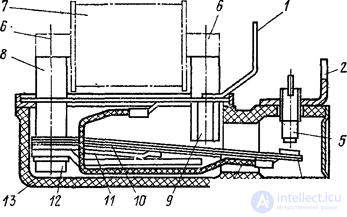Lecture
For switching of power electric circuits, the Gersikon (hermetic power contact) is intended - a reed switch with an increased switching current and additional arcing contacts. Gersykons are used in both AC and DC circuits to control elements of high-current industrial automation and electric motors with a capacity of up to 3 kW. Gersikon are issued on a current to 180 A with a speed up to 1200 inclusions an hour
Gersikon It is a reed switch with a large cummutation current and rated power than a conventional reed switch. This is achieved thanks to additional arcing contacts. The switching system, as in the reed switch, is in a gas or vacuum. Contacts are controlled using an electromagnet, the poles of which are located in a cylinder with a vacuum.

Figure Herksikon.
Gersikon type KMG-12. The current-carrying circuit of the hersicon consists of current leads 1 and 2 , flexible coupling 3 , movable contact 4 and adjustable fixed contact 5 . The electromagnetic node consists of a core 6 , a winding 7 , poles 8 , 9 , a set of ferromagnetic plates 10 and an emphasis 11 . The plates 10 are attached to the pole 8 with a screw 12 . The switching part of the apparatus is located inside a hermetic ceramic body 13 filled with an inert gas. Pressing the contacts is adjusted during the assembly process by changing the position of the fixed contact 5 . After adjustment contact 5 is soldered.
Advantages of Reed Relays
The absolute tightness of the contacts makes it possible to use them in aggressive environments, under conditions of dust, humidity, etc.
Small dimensions, light weight, simple sensor design.
The increased operating speed makes it possible to use reed switches at a high switching frequency.
Reliability of operation in a wide temperature range (from -60 to +120 degrees).
Wide range of applications in combination with relay functionality.
The presence of galvanic isolation of switching circuits and controllability of relays on reed switches.
Increased strength of electrical contacts.
Long sensor life.
Disadvantages of reed switches.
Low sensitivity of reed magnets.
Excessive susceptibility of the sensor device to magnetic fields. This requires protective measures against exposure to magnetic forces.
Reed ballon made of brittle material, sensitive to damage and impact.
The switching power is small, both in the Gersikons and in the reed switches.
At high currents, the contacts of the reed switches spontaneously open.
When operating at low frequency voltage, the contacts open and close without monitoring.
Comments
To leave a comment
Sensors
Terms: Sensors